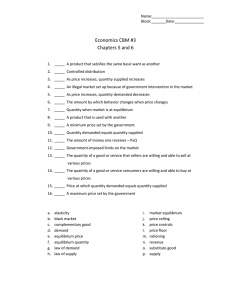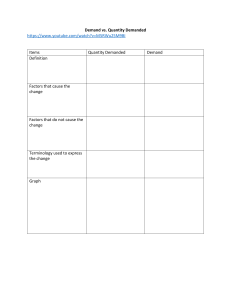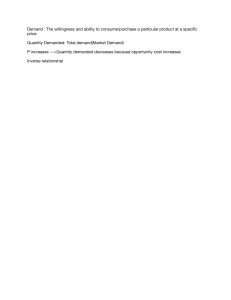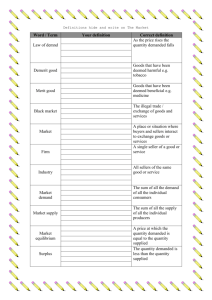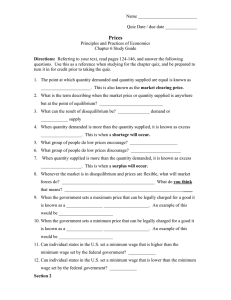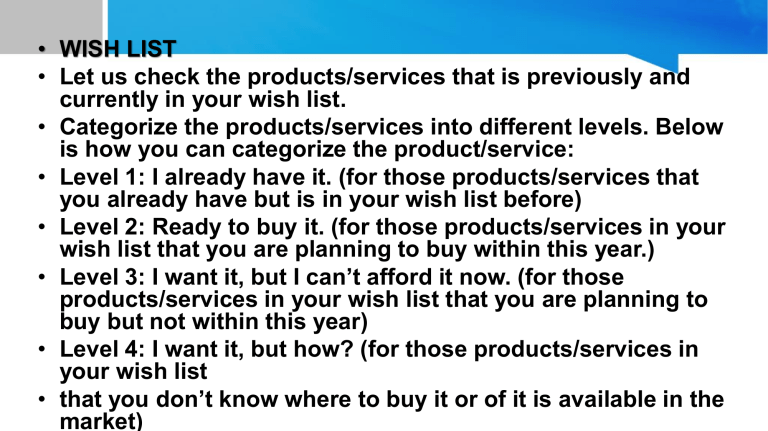
• WISH LIST • Let us check the products/services that is previously and currently in your wish list. • Categorize the products/services into different levels. Below is how you can categorize the product/service: • Level 1: I already have it. (for those products/services that you already have but is in your wish list before) • Level 2: Ready to buy it. (for those products/services in your wish list that you are planning to buy within this year.) • Level 3: I want it, but I can’t afford it now. (for those products/services in your wish list that you are planning to buy but not within this year) • Level 4: I want it, but how? (for those products/services in your wish list • that you don’t know where to buy it or of it is available in the market) Demand and Supply • If our needs and wants can be backed by our buying power, it becomes demand. It means that we have the ability and the willingness to buy the product at a given price within a given time period. On other hand, the supply refers to the quantity of goods and services that firms are ready and willing to sell at a given price within a period (Viray and Avila-Bato 2018). THE LAW OF DEMAND • The law of demand states that: all other things remain constant (Ceteris Paribus), the higher the price of a good the lesser the demand for that good and the lesser the price the higher the demand. THE LAW OF DEMAND • The relationship between the price and demand is inversely related. It is because of the substitution effect and income effect. Substitution effect means that if the price of Product A increases the consumer will look for its substitute and will cause decrease in quantity demanded for Product A. On the other hand, having the same income, an increase in price of a product will cause a decrease in quantity demanded because the consumer may not afford THE LAW OF SUPPLY • The law of supply states that the quantity of products offered to be sold is directly related with the price. It means that when the price increases the quantitysupplied increases too and if the price decreases the quantity supplied decreases too. Analyzing Demand • The demand can be analyzed using: • A. Demand Schedule –a table that shows the price of a good and the quantity demanded for that good at a given price within a given period. • B. Demand Curve – a graphical representation that shows the relationship between the price of a good and the quantity demanded for that good at a given price. It usually uses the information in the demand schedule. • Changes in Quantity Demanded compared to Changes in Demand • Changes in quantity demanded happened when there is a change in the demand for a product because of the change in price. For example, the quantity demanded for chicken at ₱120.00 was 10 kilos per month but when the price of the chicken increased by ₱10.00 the quantity demanded decreased to 8 kilos. Another increase in price of the chicken happened making it ₱140.00 per kilo because of that the quantity demanded decreased again to 7 kilos. • The change in demand is not always positive sometimes it falls. The change in demand may be affected by several factors such as: • Taste and preferences • Income • Seasonal products • Population change • Prices of related good (substitute/complementary goods) • Expected future prices, income and credit Analyzing Supply • The supply can be analyzed using: A. Supply Schedule - table that shows the prices of a good and the quantity supplied at each price at a given point of time B. Supply Curve - a graphical representation that shows the relationship between the price of a good and the quantity supplied at a given point of time. Change in Quantity Supplied compared to Changes in Supply • Changes in quantity supplied happened when there is change in the quantity of goods produced to be sold because of the change in price. It happens because businessman or entrepreneurs prepared to sell their goods at a higher price to yield more profit. For instance, an online seller of chicken dishes has following supply schedule that shows how many packs of chicken dishes he prepares at a different price. • Figure 1 shows the graphical representation of the supply schedule in Table 3. It is positively slope showing that the price and quantity supplied are inversely related. Table 3 and Figure 3 shows the change in quantity supplied because of the change in price. • Changes in supply is a shift of supply curve because of some factors other than price. For example, the quantity supplied in Table 3 changes not because of the change in price but because of the increase in the number of online sellers offering the same product. The table below shows the new supply schedule. • Factors that can Cause Changes in Supply • Technology • Cost of production • Number of sellers • Government policies (Taxes and subsidies) • State of nature (weather) • Prices of related goods produced • Future expectations (possible increase in Market Equilibrium QUANTITY DEMANDED = QUANTITY SUPPLIED • As stated in the law and supply and demand, market equilibrium happens when there is an equal demand and supply causing the price to remain the same. • When the supply is greater than the demand it causes the price to decrease but when the demand is greater than the supply the price increases. • Equilibrium market price – price agreed by the buyer and seller • Figure 5 shows the equilibrium between the quantity demanded and quantity supplied. It is the point of intersection between the supply and the demand curves. It shows that the Equilibrium price (Pe) is 25 and the equilibrium quantity (Qe) is 140. It means that if the price and quantity change there will be market disequilibrium (shortage/surplus). • When the quantity supplied is greater than quantity demanded there will be surplus. On the other hand, shortage is when the quantity demanded is greater than quantity supplied. • Change in demand or supply may result to the changes in market equilibrium. • To protect the seller or the buyer when there is market disequilibrium the government sets the minimum price (floor price) or maximum price (ceiling price) for some goods, this is what we called price control. Elasticity of Demand and Supply • Price Elasticity of Demand • Price elasticity of demand measures the change in demand in response to the change in price. For example, the price of pork increases by 5 % the price elasticity will be determined by identifying the percentage of decrease or increase in demand due to the change in price.

